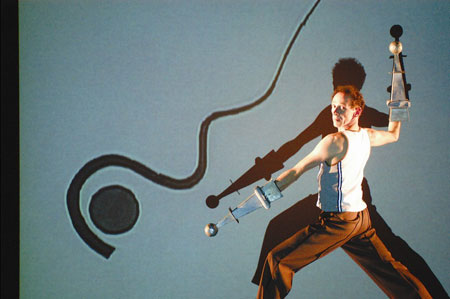Dominique Boivin: Doing it 'My Way'
|
|
|
French dancer and choreographer Dominique Boivin. |
If you happened to walk unawares into French dancer and choreographer Dominique Boivin's creative show La Danse, Une Histoire à Ma Faon (A History of Dance, My Way) at the BeijingDance/LDTX theater, you might easily have mistaken it for a children's play or even a circus act: Wearing a clownish costume of light brown hat, vest, tracksuit bottoms and trainers, the dancer, in his late 50s, appears on all fours, with a voiceover explaining, "At the very beginning, the origins of dance were not clear."
Then he dons an oversized paper mask with a face painted on to the accompaniment of tribal-sounding language.
Sense of humor
Boivin's work goes on to retrace key stages in the history of dance, from ancient until modern times, via practitioners such as Isadora Duncan, Vaslav Nijinski, Martha Graham and Merce Cunningham, while using minimal props, such as a stick and pieces of lace and black cloth.
His humorous La Danse, with little in the way of conventional moves, enchanted an audience of equally enthusiastic children and adults, as Boivin attempted to erase the gap between artwork and reality.
Don Quichotte (Don Quixote), also solo, was performed two nights earlier, courtesy of the Croisements Festival 2011 and focuses on the Don's solitary imagination. With his natural, non-specialized movements, Boivin emphasizes the unadorned body as an objet d'art in itself.
Boivin, whose Transports Exceptionnels (Exceptional Transport), a spectacular duet between man and machine featuring Philippe Priasso and an earth-digger, was also performed in China last year, wishes to show "dance as play" – and play as dance.
"I want to give some serious topics a light-hearted touch and make them fun," said Boivin, who is also artistic director for Beau Geste (Graceful Gesture), a modern dance company well known for diversity and humor.
"With this solo [La Danse], the most interesting point for me was to touch on the awfully serious aspect that dancers – and even the general public – tend to associate with dance; this tacit agreement that humor and dance can't go together," he explained.
The piece, which was created in 1994 to give the public a sense of the history of dance, has been constantly performed in more than 40 countries ever since.
Classical restraints
Making his acrobatic debut on stage aged six, Boivin's funny bones come partly from his uncle, a professional clown, as well as being inspired by Charlie Chaplin and Boivin's favorite French director, Jacques Tati. Boivin moved onto classical dance before he began to take courses, at age 18, with modern masters including Carolyn Carlson, Alwin Nikolais and Cunningham. To him, classical ballet is "bourgeois and quaint" while modern dance gives him freedom for expression.
"Classical dance is like grammar...There are too many rules and regulations," according to Boivin. "Modern dance enables you to express your current status in a more honest way, as what you look like today is probably different from how you appear tomorrow."
Having performed La Danse for 17 years, he aspires to continue until his 80s. "I'll be very old in 20 years but I will dance it with my body conditions at that time. "
His sources of inspiration can come from anywhere and anything. "Sometimes I have some ideas that even I don't know where they come from…I would then create a dance based on them after some serious thinking," said Boivin. For example, he said, he might decide to create a dance based on the pair of sunglasses he's wearing. "The process of artistic creation is... to adapt. You need to get used to it and then work with your own intuition and inspiration. It is just like life."
Since he set up Beau Geste in 1981, he has been emphasizing personality and movement. Thanks to a rich repertoire, including works such as Mécaniques (Mechanical) and Spectacle Jeune Public (A Show for Youth), he has become one of France's most inventive and celebrated choreographers.
With a diverse fanbase, he creates works with the fundamental rule of touching his audience. For artists, the most important thing is to "be curious."
"For French artists, art is their mission… the success of a performance should not be judged by how much applause it can get from the audience but if the audience can go into his performance and get what the dancer wanted to express," he explained.
With government funding, Boivin is able to create works that do not cater to mainstream tastes. "We don't please the audience, but the other way round," he laughed. Though funding is limited, "we don't have to worry too much about ticket sales or the audience's likes. We are granted a more free environment for our creation." It is a message Boivin enjoys bringing to China.
 0
0 








Go to Forum >>0 Comments